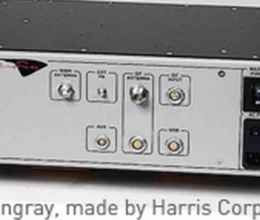The Stingray doesn’t need eyes to hunt. The flat, boneless fish uses special sensors to detect the electrical signals of surrounding prey. Then, it attacks—sucking its meal up from underneath its body.
It’s a fitting name for the fake cellular tower manufactured by the Harris Corporation. The Stingray, like its namesake, tracks targets by detecting and exploiting signals. The devices, also known as IMSI catchers and cell-site simulators, are small enough to fit in the back of a police van, but they’re capable of tricking all phones within range into pinging it and revealing their unique identifying numbers and locations. Some models are even capable of accessing cell phone browser activity, SMS text messages, and the content of phone calls.
Law enforcement agencies across the country now have at their fingertips a vast arsenal of technology that allows them to track your movements and intrude on your private life in ways we could not have imaged a few decades ago.
Law enforcement agencies across the country now have at their fingertips a vast arsenal of technology that allows them to track your movements and intrude on your private life in ways we could not have imaged a few decades ago.
Drones give police an eye in the sky, facial recognition-linked cameras give them eyes on the ground, and predictive policing programs project their eyes into the future.
Surveillance technology has developed so quickly that laws and policies meant to protect the public’s privacy have not kept up with new methods. Sometimes, the public isn’t even aware that a new surveillance technology exists. The ACLU plays a critical role investigating these technologies, ensuring they see the light of day and that they are not employed without proper oversight and accountability.
In July 2017, we sued the Albuquerque Police Department (APD) for its refusal to disclose information on whether or not it possessed Stingrays. That lawsuit, which was settled in January, 2018 revealed that APD has possessed technology manufactured by the Harris Corporation since at least 2014, and similar technology manufactured by DRT since 2012.
When acquiring the devices, the department never consulted or informed the public. If not for our lawsuit, we’d likely still not know of their existence. A matrix of non-disclosure agreements between manufacturers of the technology, the FBI, and local law enforcement, prevent local law enforcement from disclosing ownership and use of the technology to the public, or even to the courts when presenting evidence gathered using the devices.
Bringing these powerful technologies into public view was an important first step in protecting New Mexicans’ privacy rights. But we didn’t stop there.
After the lawsuit settled, a team from the ACLU of New Mexico met with representatives from the City of Albuquerque and from APD. We wanted to know: How were police using Stingrays? How often were they deploying them? What privacy protections, if any, were in place for the public? Did the department require officers to obtain a warrant before using them? Was anybody overseeing and auditing the use of the technology? What was the department doing with the data afterwards?
We left that meeting with serious doubts that APD was adequately protecting the public’s privacy. The non-disclosure agreements with Harris Corporation and the FBI prevented representatives from the City and APD from even fully answering most of our questions. Unsettled, we urged the department to put in place a suitable and comprehensive policy that would better protect the civil liberties of New Mexicans.
Shortly after, by the City’s invitation, we drafted policy recommendations to guide the use of cell-site simulator technology, many of which APD incorporated into its draft Standard Operating Procedure. Albuquerque residents now have a measure of protection. The policy requires officers to get a warrant, excepting exigent circumstances, before using the technology; prohibits the use of the technology for accessing the contents of communications; requires APD to keep a log detailing when the technology is used, and conduct a monthly audit to ensure compliance with the law.
Albuquerque residents now have a measure of protection.
As we look toward the future, we can be certain that police departments will seek to deploy new and more powerful technologies. Some, like the Stingray, will be developed by the military and adapted for law enforcement use. Others, will come from corporate giants, like Amazon, who is currently marketing advanced facial recognition technology to federal and local law enforcement agencies across the country.
At the same time, all of us will continue to acquire advanced technology for our everyday use that vastly expands our digital footprint, including data concerning the most intimate aspects of our lives.
The ACLU will fight to protect and expand your privacy rights along the way.
Just this past summer, the national ACLU won the biggest privacy rights victory of the digital age.
Just this past summer, the national ACLU won the biggest privacy rights victory of the digital age. In Carpenter v. the United States, the Supreme Court ruled that police must obtain a warrant before they can seize information about people’s location history from cell phone companies. While the ruling is limited to historical data, the Court’s decision leaves open the possibility for the future protection of other kinds of data, like that generated by your smartphone and other connected devices.
In nature,the Stingray’s prey has no idea that their electric fields make them targets. We, however, know better. We realize the technology that we depend upon to get us from point A to point B, to communicate with family and friends, and to document our lives, is also a target of big fish—or Big Brother. Because of this, we remain vigilant and continue to fight for a future in which the Fourth Amendment fully protects both your physical and digital privacy from prying eyes.
Originally published in the winter 2018 edition of The Torch.






